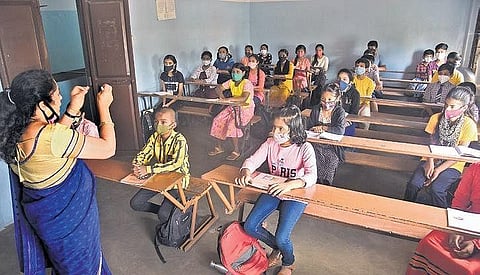

BENGALURU: Continuous school closures and the limited reach of online/remote learning in the last 18 months have had “catastrophic consequences for children, on the academic, emotional, nutritional, social, and economic fronts,” states the National Coalition on Education Emergency (NCEE) in its September 5 report - ‘End Education Exclusion: Resume and Renew Education for 26 crore Children.’
The NCEE - a coalition of 70 academics and activists in the country - has summarised data obtained from studies conducted across India and selected international studies between early 2020 and mid-2021.
They have highlighted the challenges of online pedagogy and requested the government for “safe” re-opening of schools, from anganwadi to high school, at the earliest with necessary steps such as vaccination of teaching and non-teaching staff and taking parents into confidence on the importance of offline education.
“More than 90 percent of underprivileged parents (97pc in rural areas) want schools to reopen . Children from marginalised communities do not have internet or cell phones. Only four percent of students in rural areas have access to essential digital infrastructure; over 80 percent of students in urban areas do not have access to essential digital infrastructure,” the report states, quoting several studies conducted since the onset of the pandemic last year and the resultant online education.
“Only 4 per cent of SC and STs, 8 per cent of Muslims, and seven percent of OBC students had access to essential digital infrastructure,” it added.
The coalition has also highlighted the gender inequality in access to gadgets for online education.
“A recent survey of 3,176 households across four Indian states conducted by the Centre for Budget and Policy Studies, found that in more than 70 percent of the households, the phone belonged to a male member. Only 26 per cent of the girls, who responded to the survey said that they had unhindered access to phones at home. Girls spent a disproportionate amount of time on chores and care work and less time on education,” added the report.
As early as mid-2020, the UNESCO had estimated that about 14 crore students in primary schools and 13 crores in secondary schools had been affected by the lockdown in India.
The UNICEF, 2021 report, states that more than half of the teachers surveyed perceive remote learning materials and methods to be less effective than classroom teachings.
The closure of schools has also led to inability of children to access cooked meals and is likely to have had a detrimental effect on their nutrition and health. The impact may be worse for girls and children from marginalised groups.